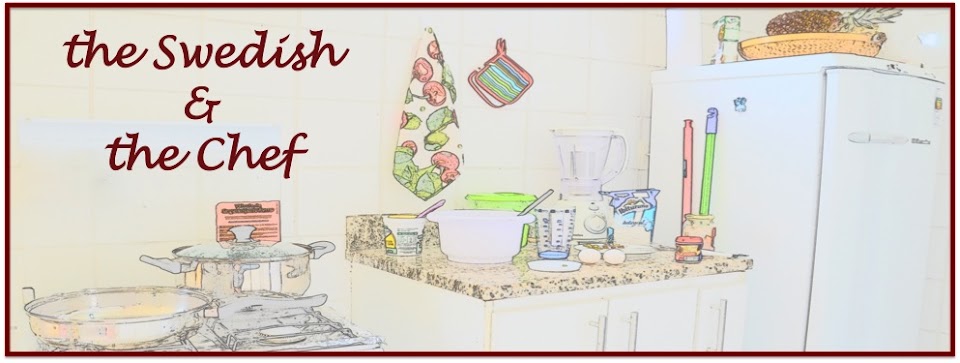Easter is a holiday full of different traditions.
There is the Easter bunny that brings chocolate eggs. Sometimes it hides them in the backyard and children have to find them (Sweden).
There is the dyed eggs by grandparents that use specific flowers, herbs and onion peels as dye, and offer the colourful eggs to their grand children (Portugal).
There is the godparents cake offered to their godsons, that in return cook/buy the Easter lunch for everybody (also Portugal).
There is also the tradition of the family meal full of recipes using salted codfish (Brazil).
Salted codfish is a portuguese must (and påskmust is a Swedish must :) ), present in so many recipes and cooked in 1001 ways, as it's traditionally said. For Portuguese, salted codfish is a Christmas item, however, in Brazil it is most popular for Easter. Today, far from being in a big family Easter lunch (it was just the Swedish and the Chef), we wanted to create something less traditional but still using ingredients that are common in this season. We came up with a combination of eggs and salted cod. The recipe might be Spanish, but the style is totally Portuguese!
Happy Easter everyone!
Ingredients (for 1 omelette):
300g potatoes
200g salted cod fish fillets
300ml olive oil
4 eggs
1 small onion
Salt
Peel off the potatoes and cut them in 2 mm thick pieces, using a mandolin.
Heat up the olive oil in a frying pan, and add the potato pieces. Cook at very low heat, so the olive oil is just boiling gently. When the potatoes start to soften, use a chasseur turner to gently cut the potato slices into smaller pieces (see picture on the left). Add the onion and the cod fish, chopped finely, and cook until everything has softened (~20 min.), using the turner now and then to keep breaking the ingredients.
In the meantime, beat the eggs in a bowl and season with salt. When the potato/egg/cod mixture is ready, scoop it out from the frying pan and add to the eggs mixture. Stir everything and have a taste. Add more salt if needed.
 Grease a narrow-deep frying pan (we used 20cm diameter, 5cm deep pan), with some olive oil, and heat it up. Pour in the omelette mixture and reduce the fire for a slow cook, for about 5 minutes. Dip a turner in the center and check how far it has cooked (cooked part will be hard). When you think it has cooked half way through, it is almost time to turn it. Before turning, loose the edges as much as you can, using a spatula or fork. Remove the pan from the fire, cover it with a flat dish slightly bigger than the pan and turn the omelette onto the plate. Immediately after, slide the contents of the plate back in the pan and put back on the stove. Cook for another 2-5 minutes, depending on how raw you want the center of the omelette (see picture on the right).
Grease a narrow-deep frying pan (we used 20cm diameter, 5cm deep pan), with some olive oil, and heat it up. Pour in the omelette mixture and reduce the fire for a slow cook, for about 5 minutes. Dip a turner in the center and check how far it has cooked (cooked part will be hard). When you think it has cooked half way through, it is almost time to turn it. Before turning, loose the edges as much as you can, using a spatula or fork. Remove the pan from the fire, cover it with a flat dish slightly bigger than the pan and turn the omelette onto the plate. Immediately after, slide the contents of the plate back in the pan and put back on the stove. Cook for another 2-5 minutes, depending on how raw you want the center of the omelette (see picture on the right).
Serve warm.
Notes:
The cooking times totally depend on how low you can bring your heat, the size of the pan, and even on the quality of the olive oil (different olive oils have different boiling points). However, this recipe is a lot easier than it looks, just trust your instincts.
For the TRADITIONAL recipe of Spanish Omelette use 500g of potatoes and eliminate the codfish.
This recipe was inspired by the Tortilla de Patata of Elena Del Corro, spanish herself.









